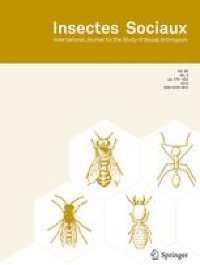Laboratory studies on insects face the dual challenge of maintaining organisms under artificial conditions, and in reduced spaces while mimicking the species’ ecological requirements as much as possible. Over decades, myrmecologists have developed and continuously improved laboratory methods and artificial nests for rearing ants. However, the setups commonly used to house colony fragments of few individuals or even isolated individuals present disadvantages such as insufficient ventilation, difficult access to specific workers, and problems with water delivery. Here, we developed and tested a new setup for keeping ants or similar sized insects in small groups. The setup consisted of a Petri dish containing a piece of plaster connected underneath to a water tank by a sponge. The sponge is immersed in the water on one side and embedded in the plaster on the other side, maintaining the plaster permanently moist and thus offering a water source to the ants. We tested the setup with two ant species of different sizes, Platythyrea punctata and Cardiocondyla obscurior in feeding, starvation, and desiccation conditions. Our results showed that our new setup worked equally well for both species in all conditions in comparison to a more conventional setup with the advantage of reducing maintenance costs and ant manipulation, but also preventing death by drowning and offering water ad libitum. The setup was quick to build, with cheap and reusable materials for further experiments. Therefore, we are confident that it will facilitate future studies on isolated or small groups of individuals and that such a standardized setup will make future studies more comparable.




They may live the same age, but do they die happy, bored, or depressed?
I had the same thought.
I don’t know. I think that lifespan is probably used as a metric when it comes to insects because it is probably difficult to measure other parameters. I suspect that short-term stress can be quantified by looking at how much the insect is moving, but after the burst of activity dies down the insect could still be stressed. Maybe the underlying idea is that insects that are under high-stress will tend to have shorter lifespans, and so we can infer that long-lived insects are happy. This doesn’t only have moral implications, but also from the point of the view of the reliability of the experiments the researcher would want stress-free animals.
I don’t know if insects express strong molecular markers of stress (like cortisol) and I wonder how hard it would be quantify that. Ants are quite small, so I can image collecting stress hormones might be tricky. And the ants will probably be stressed in the process… It is a good question.
Maybe they could bridge it to a conventional one and let the ants choose. If most ants choose the conventional side most of the time, then something is up